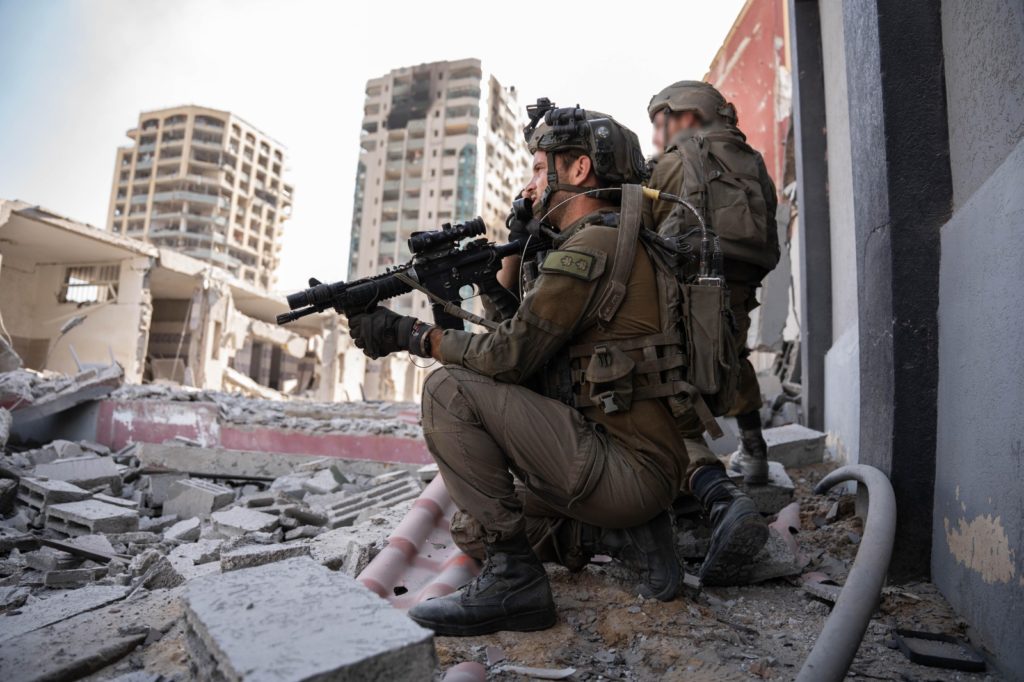Australia/Israel Review
“Integrated warfare”: The secret to the IDF’s Gaza success
Nov 27, 2023 | Yonah Jeremy Bob

Since October 7, the Jerusalem Post has visited four different IDF locations on the southern front, and two air force bases, and embedded with a navy fast boat off the coast of Gaza; several of these visits took place in recent days.
What emerged from all this begins to explain some of the IDF’s failures on October 7. More importantly, though, it establishes an understanding of how the IDF’s revolutionised and integrated approach to warfare kicked it into high gear in its offensive, and effectively changed the narrative in the war with Hamas.
Field command centres are handling real-time targeting decisions, and intelligence command centres are providing human spying, signals intelligence, satellite intelligence, cyber intelligence, and other items to the targeting centres.
During one of the targeting command centre visits, an interview was interrupted for 30 seconds. During that time, the targeting commander integrated new field intelligence and seamlessly passed it on to another field or air unit – within minutes, Hamas targets were destroyed.
And on the fast boat, intelligence came through that IDF Unit 401 was about to be ambushed by Hamas. This information came from an intelligence centre, through a targeting centre, and then to the navy, which fired around a dozen shells from a missile boat, killing the targets.
A senior air defence official presented a picture of how IDF air defence monitors look during a “normal” volume of rocket attacks – as opposed to the 3,000 rockets that were fired in a four-hour timespan on October 7.
The difference lay in a series of quantifiable and not-too-hard-to-follow arrows or streaks across a screen, versus the entire screen being filled with streams until it seemed unintelligible to human eyes, and only the IDF automatic air defence aspects could fully follow it.
Still, that automatic system responded and, with some delay, the human interpreters responded as well and were also able to analyse and rapidly share the data with other critical units.
Between signals and cyber intelligence Unit 8200, air force surveillance Unit 9900, and human spying Unit 504, the IDF has always passed around intelligence to assist with targeting and defence, both in the field and on the home front.
The rapid pace and incredible integration have reached new levels in this war.
In some ways, none of this should come as a surprise. For years, the IDF talked up a new level of integration between different intelligence units and sea, air, and land forces.
In one pre-war visit, the Post met with a commander of the IDF’s secret artificial intelligence target bank, where sharing intelligence and operational targeting has moved to almost light-speed.
Yet given that much of the latest revolution was post-2019, this was only really used by the air force, and statements about using the new systems, capabilities and speed for the land forces were speculative.
It was worse than speculative, because given Hamas’ capability to fight from a massive network of underground tunnels, operate out of civilian sites like hospitals and mosques, and booby-trap any spot where IDF troops might try to find shelter or take a rest, there was every reason to believe that Hamas could neutralise the IDF’s technological advantages.
If all you need to do is booby-trap a house, then light-speed satellites, drones, ultra-networked land vehicles, artillery and tanks do not help.
That is the first premise of asymmetric guerrilla warfare, and is the reason why the Vietnamese and Afghans, for example, were able to defeat far stronger forces such as the US and Soviet militaries.
Some might say that the US had threaded the needle of urban guerrilla warfare in its fighting against ISIS in Syria and Iraq. But in those cases, there were also significant local forces on the ground to fight ISIS, and the entire globe supported overwhelming uses of firepower, even in the face of enormous civilian casualties there.
There are no agreed-upon estimates of civilian casualties in Iraq, but the lowest number tends to break 100,000 and the higher number could reach several hundred thousand.
This means that the US and its allies had far more “rope” with which to inflict “collateral damage” in fighting ISIS than Israel has against Hamas. In Gaza, a Hamas-run health ministry estimate of 11,000 Gazans (as of Nov. 15), including untold numbers of Hamas terrorists, is sufficient to bring global pressure on Israel for a ceasefire.
As of Nov. 20, 66 IDF soldiers had been killed in the invasion of Gaza compared with a 2014 estimate that IDF losses would hit 500-1,000 soldiers if a deeper ground invasion was implemented.
Instead, the IDF has managed to achieve a mix of new tactics, intelligence collection, speed, and distribution of intelligence, which allows air, sea, artillery, and tank forces to eliminate 150 Hamas forces in one extended battle, without a single IDF loss, as was the case recently.
This new integrated warfare, reducing IDF casualties by several orders of magnitude, has also allowed the IDF to continue the ground invasion, much as the Iron Dome has allowed the IDF to continue airstrikes even in the face of rocket attacks on the home front.
Speaking to a wide range of IDF officials at all levels, it is clear that they know they have created a new kind of integrated warfare, which has transformed the battlefield with Hamas.
But whether the impressive gains of this new kind of warfare are sufficient to deter Hezbollah, Iran, and other Shi’ite proxies from crossing certain Israeli red lines is still unclear.






